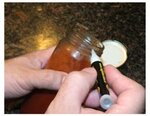Zippythehog
Staff Sergeant
- 760
- Jan 7, 2017
When the weather turns cold and dry, my fingertips crack at the nails. I use a dab of superglue and kicker to seal it over.
Does anyone else do this?
Wurger, I didn't know where else to post this, so I understand if you move it.
Zip
Does anyone else do this?
Wurger, I didn't know where else to post this, so I understand if you move it.
Zip

